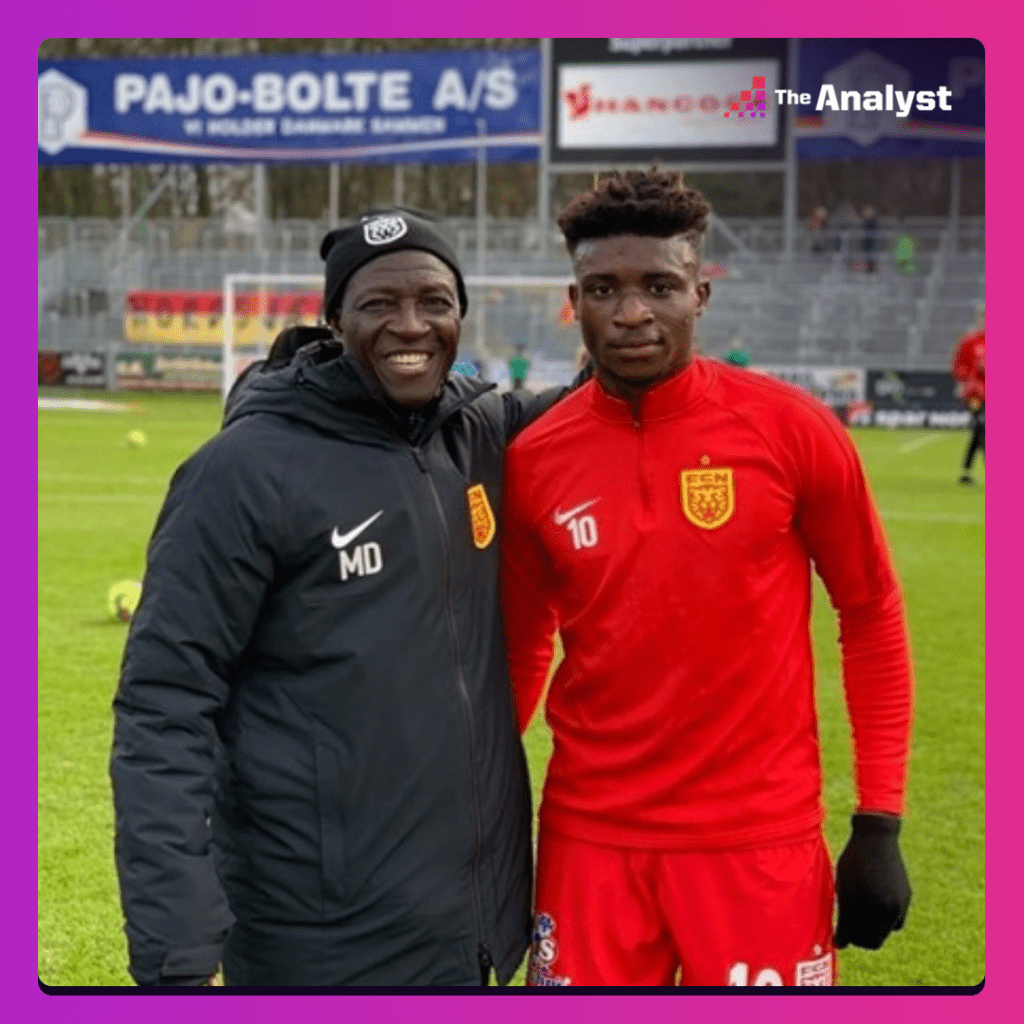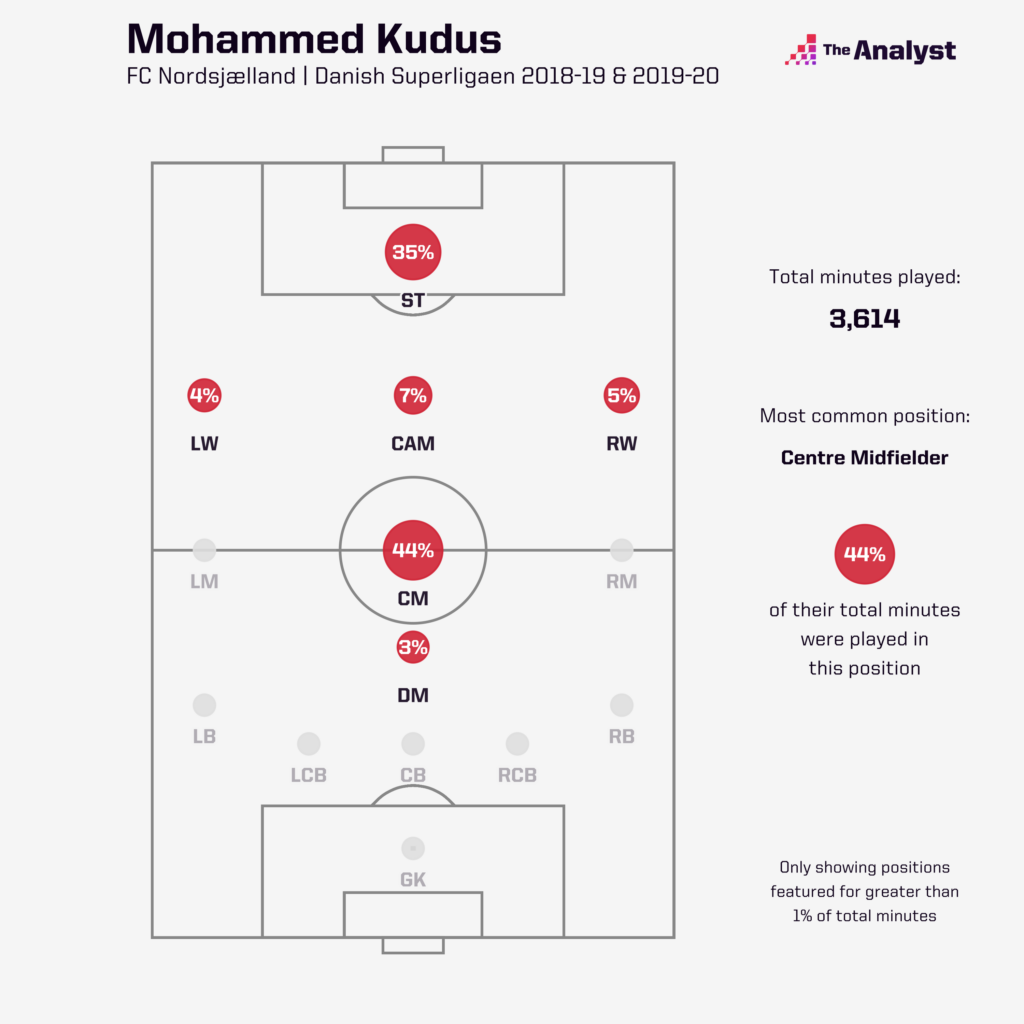The year is 2018 and Mohammed Kudus is tucked into his bed at the Nordsjælland base two days after making his 11th appearance for the club. It’s November in Denmark, one of the coldest months in the Scandinavian autumn. Kudus, who joined from Right to Dream Academy, logs into Instagram and makes a post which he will look back on in four years with a strong sense of fulfilment.
He shares a picture of a Thiago Alcantara Bayern Munich jersey which had been signed by the whole first team including the Spanish midfielder. It was an away kit which the Bavarians wore five days prior when they beat FSV Mainz 05 away. In his caption, Kudus says: “Anyone that knows me up-close knows how much this means to me.”
For people close to the Ghanaian, it was a childhood dream come true. Growing up, Kudus was a diehard Barcelona fan and fell in love with Thiago who played for the first team between 2009 and 2013. His love for Thiago was so apparent that his team-mates from juvenile football referred to Kudus as Alcantara and with time the moniker stuck.
So, when Ajax faced Liverpool in the UEFA Champions League this season, it was an emotional night for Kudus, who got the chance to share the Anfield pitch with his childhood idol. But it may not have been in the capacity the Ghanaian would have preferred as he would have relished battling it out in midfield with Thiago throughout the game.
Instead, Kudus was on the other end of the field playing as a striker, scoring a magnificent goal that got the whole world talking. So far, the 22-year-old has barely put a foot wrong this season, scoring seven goals in all competitions. However, is playing upfront the best option for the Ghanaian going forward?
Born With Versatility
Kudus was born and raised in Nima, a shanty settlement in Accra, by his mother and grandmother. As a youngster, he had the rare opportunity to go on trial with Feyenoord, now known as WAFA (West African Football Academy). To his surprise, he was mostly used as a left-back and never really got a chance to prove his worth. Missing out at Feyenoord crushed young Kudus, but he was undeterred.
He persevered with his boyhood club, Nima-based Strong Tower FC, until his breakthrough came in 2012. Right to Dream Academy’s U11 side had gone the entire year winning each game in dominant fashion. But that changed when they came up against Strong Tower. The friendly became a 6-6 goalfest, with Kudus scoring all six goals for his side.
It was a special day for the young left-footed player, who dazzled in his favourite attacking midfield role as he single-handedly brought Right to Dream’s winning streak to an end. Any time Strong Tower had the ball, all you could hear was their coach yelling “give the ball to the world’s best [Kudus]”.
Every individual at that friendly left with the name Mohammed Kudus buzzing in their heads. Right to Dream immediately made their intentions clear – they wanted him. Nevertheless, it still took about a week or two to convince the wary kid who still had nightmares from his last encounter with an academy (Feyenoord).
Eventually, Kudus joined Right to Dream and formed a key part of their golden generation. They went unbeaten at U15 level in their European tour, winning the last edition of Nike’s World U15 Premier Cup, Marveld Tournament, Top C Tournament, and NI Milk Cup (now known as SuperCupNI). The only time the team drew a game was against Manchester City’s U15 team which had the likes of Phil Foden (a goalscorer on the day), Jadon Sancho, and Raphael Camacho. In all these games, Kudus was used predominantly as an attacking midfielder, but also enjoyed spells as a box-to-box midfielder.
Six years after joining Right to Dream, Kudus signed for Nordsjælland where he made his debut for the club just three days after he turned 18 – at the time he became the ninth youngest debutant in the club’s history.
Right from kick-off the Ghanaian played in an unfamiliar striker role and didn’t have the best of games before he was substituted at half time.

Black Stars assistant coach Dramani Mas-Ud Didi, who worked with Kudus in his latter days at Right to Dream and Nordsjælland, told Joy Sports in 2020 that the player went through “total transformation” when he moved to Denmark.
“At FC Nordsjælland, Kudus got his major education in football where he developed various aspects of his game by playing in different positions as a central midfielder, false nine, wide midfield, wide attacker etc.”
This is seen in the breakdown of the positions the Ghanaian played in during his two-year stay in Denmark. He was tested in six different positions with the Ghanaian playing 44% of his minutes as a central midfielder, 35% of his games as a deeper-lying striker with other 21% being taken up mainly in attacking midfield positions.

Fundamentally, Kudus spent his first season mainly playing in midfield and played the next as a false nine. Despite switching roles, his underlying creation numbers remained quite similar in both seasons. He managed an expected assist (xA) tally of 0.09 per 90 in both seasons, while his second season saw him create 1.3 chances per 90 (slightly above the 1.2 chances he created in his first.).
But while Kudus hardly changed as a creator, he exploded as a forward due to the position change. He scored 11 goals in his second season, compared to a paltry three in his debut campaign. This was due partly to an increased quality of goalscoring positions that he found himself in, averaging a non-penalty xG tally of 0.36 per 90 – almost twice as much as he had in the first season. Kudus was also attempting twice the number of shots per 90 (2.9) as a false nine, so it came as no surprise when Ajax came knocking.
An Ambivalent Season So Far
The 2022-23 season is Kudus’ third season at Ajax. Considering the trajectory which the Ghanaian started life in Netherlands – scoring one and assisting three in his first three games – he should have probably moved to a bigger club by now.
He almost got that move this summer but for different reasons, as injuries have hampered the development of the former Nordsjælland player. Prior to this season, Kudus had suffered three major injuries, missing out on 41 possible games under Erik ten Hag at the club.
Kudus thought he had been given a new lease of life after the appointment of Alfred Schreuder as new head coach of Ajax. All indications pointed to a redemption season for the Ghanaian after he averaged a goal every 36 minutes in pre-season. Kudus continued his good form and scored a cracker which only turned out to be a consolation as Ajax narrowly lost the Johan Cruijff Schaal to rivals PSV.
What followed was a series of cameo appearances which left the Ghanaian dissatisfied. Despite his blistering form, Kudus was only handed a total of 42 minutes in the first four league games. He subsequently vented his frustration through cryptic social media posts.
At one point, it felt like Ajax had seen the last of Kudus, who failed to show up to training on deadline day in order to force a move to Everton. In the end, the Dutch champions stamped their authority by refusing to sell the 22-year-old. Kudus, looking back on the summer transfer window, believes it was necessary for him to take that time off training to clear his head.
“It wasn’t that I didn’t want to train, but I’m human and had a lot to deal with in a very short time. The chapter is now over and I’m still here,” he told NOS.
He went on to add: “Everton offered me a great opportunity and I wanted to try it. No footballer wants to sit on the bench and neither do I.”
Kudus finally got his wish as he was rewarded with 45 minutes against Cambuur. He came on for Brian Brobbey in the second half and scored after just 20 minutes. Kudus has since not left the Ajax starting XI, starting the last four games in place of Brobbey.
So far this season, Kudus has scored six goals from 13 shots across the Champions League and Eredivisie combined. Playing as a false nine has enabled the youngster to equal his best scoring tally in the league for Ajax despite playing 573 minutes fewer. He is taking his shots from more quality areas (within the box), reflected by his 0.3 xG per shot in the map below:

Kudus can’t stop scoring, which is surely music to Schreuder’s ears. But if the Dutch manager cups his ears to listen carefully, he might hear undertones of displeasure from Brobbey, who seems to have fallen out of favour.

Currently, Kudus is outscoring Brobbey but the sample size for this season is too small to compare. If you look back at data from the start of last season, it’s evident that both players love to take aim, with Kudus averaging 3.2 shots per 90 whilst Brobbey averaged 3.1.
It is important to note that Kudus played the most part of last season in midfield, hence his superior xA of 0.29 per 90 compared to Brobbey’s 0.20. Despite the underlying numbers, Brobbey edged out Kudus for assists, chalking 0.35 per 90 to Kudus’ 0.14. This possibly suggests that team-mates are failing to convert the chances Kudus creates in games, hence, the low assists numbers.
Defensively, Kudus has put in more of a shift since the start of last season, which is in keeping with his midfield role. The Ghanaian registered more tackles (1.7), interceptions (0.4) and recoveries (8.4) per 90 than Brobbey.
Brobbey has also made it public that he wants more minutes. After he was dropped for the Champions League game against Rangers, the striker said: “I was a little frustrated. Which I think is normal, because you want to play.”
The 20-year-old admits there is competition between himself and Kudus. The difference is, Brobbey can only play as a striker, but Kudus can pretty much play everywhere from midfield to attack.
The Way Forward
Schreuder recently said to the media after the Rangers game: “I did say to him [Kudus]; don’t start thinking: oh dear, the trainer no longer sees me as a midfielder. It is not like that. But I am charmed by him in the front.”
Nobody knows when that charm will dissipate, but one thing we can establish is that this is unlikely to be a permanent move judging from Schreuder’s assertion.
In the false nine role, Kudus is able to demonstrate his versatility and dynamism as he drops into deeper areas to facilitate play and also arrives in the box to finish off attacks. It plays to his strengths because he is strong on the ball and can easily manoeuvre his way through tight spaces.
The idea of playing Kudus in a false nine wasn’t birthed overnight. It was an auxiliary plan Schreuder had worked on in training during pre-season. In the friendly against Red Bull Salzburg, Kudus started in that role and scored a well-placed header which followed a late run into the box. Realistically, Ajax are stacked in midfield with the likes of Dusan Tadic, Steven Berghuis, Day Klaassen, Keneth Taylor, Edson Alvarez, and Florian Grillitsch.
Contrastingly, it looks like there might be more room for him in attack. Schreuder confirmed to Ajax TV that his plan was to use the Ghanaian upfront this season.
“He plays very much on intuition and that means that he is very difficult for the opponent to defend. He is also very strong and agile. It’s not an experiment, because I don’t just do things. There really is an idea behind it. It’s certainly an option to list him as number nine or seven.”
However, there is a conflict, because in Kudus’ eyes he views himself as an attacking midfielder. Against Rangers, Kudus played the perfect game for a false nine. He won the man of the match after becoming the first player since Serge Gnabry in 2020 to score a goal, provide an assist and complete all of his passes (27/27) in a single Champions League game.

As a young player on a European night, Kudus was expected to be dozing off into euphoria but when Dutch media outlet RTL7 quizzed him about playing as a false nine, the Ghanaian realistically responded by saying: “I’m not a striker, but I give everything in every position. I’m an attacking midfielder, but it’s for the team. If I have to play elsewhere for the team, I’m happy to do that.”
Does Kudus feel good about playing as a striker? Of course, he does. Remember, he transitioned from being subbed on after the 90th minute this season to being a starter. Any significant gametime is an upgrade, even in an unfavourable position. The more important question though, is whether playing up front as a false nine is optimal for the Ghanaian. Although it plays to most of his strengths, it takes away a key element of Kudus’ game: feeling connected in games.
In their last two games away to Liverpool and AZ Alkmaar, Kudus has looked isolated up front, whilst his team-mates have failed to dominate possession and territory. In both instances, Kudus still managed to score and that’s because he is getting into the box a lot more often this season. As a result, he is currently accumulating a career best xG per 90 of 1.43 – a rate that will be near impossible to sustain. He has so far proved to be a lethal finisher, scoring 1.59 goals per 90 from those chances – a quite ridiculous return as we head into the first international break of 2022-23.

With the 22-year-old attempting an average of four shots per 90, it is anticipated that he will continue to score a lot more if he continues to play as a false nine at Ajax. At this rate, he will most likely smash his record of 11 goals in a season, barring any injuries.
On the other hand, he is touching the ball a lot less and can’t really influence games as much as he would like. So far, he’s only making 5.9 progressive carries per 90 – the lowest in the Ghanaian’s career to date. His xA per 90 of 0.21 is also lower than the 0.33 he managed last season from midfield.
There are benefits and drawbacks for Kudus in his role for Ajax this season. Although he may not be able to dictate the game from midfield like his idol Thiago Alcantara, he has the opportunity to engrain his name in Ajax’s long-standing history of star players to be deployed in a similar role on the pitch, which includes stars like the late, great Johan Cruyff, Rafael van der Vaart, Tadic, and Jari Litmanen.
 Mohammed Kudus received a Bayern Munich shirt (signed by the team) from his childhood role model Thiago Alcantara. During Kudus’ juvenile days, his teammates called him ‘Alcantara’.
Mohammed Kudus received a Bayern Munich shirt (signed by the team) from his childhood role model Thiago Alcantara. During Kudus’ juvenile days, his teammates called him ‘Alcantara’.




